Plus Two Zoology Chapter Wise Questions and Answers Chapter 1 Human Reproduction are part of Plus Two Zoology Chapter Wise Questions and Answers. Here we have given Plus Two Zoology Chapter Wise Questions and Answers Chapter 1 Human Reproduction.
| Board | SCERT, Kerala |
| Text Book | NCERT Based |
| Class | Plus Two |
| Subject | Zoology Chapter Wise Questions |
| Chapter | Chapter 1 |
| Chapter Name | Human Reproduction |
| Number of Questions Solved | 91 |
| Category | Kerala Plus Two |
Kerala Plus Two Zoology Chapter Wise Questions and Answers Chapter 1 Human Reproduction
Plus Two Zoology Human Reproduction One Mark Questions and Answers
Question 1.
Vasa efferentia are the ductules leading from
(a) testicular lobules to rete testis
(b) rete testis to vas deferens
(c) vas deferens to epididymis
(d) epididymis to urethra
Answer:
(b) rete testis to vas deferens.
Question 2.
In human, the unpaired male reproductive structure is
(a) seminal vesicle
(b) prostate
(c) bulbourethral gland
(d) testes
Answer:
(b) prostate.
Question 3.
The semen fluid consists of sperm cells and secretion from
(a) seminal vesicle, prostate gland, Cowper’s gland
(b) seminal vesicle, testis, uterus
(c) seminal vesicle, prostate gland, testis
(d) seminal vesicle, Cowper’s gland, and testis
Answer:
(a) seminal vesicle, prostate gland, Cowper’s gland.
Question 4.
Onset of menstruation of human female is called
(a) menopause
(b) puberty
(c) gestation
(d) menarche
Answer:
(d) menarche
Question 5.
Ovulation in the human female normally takes place during the menstrual cycle
(a) at the mid secretory phase
(b) just before the end of the secretory phase
(c) at the beginning of the proliferative phase
(d) at the end of the proliferative phase
Answer:
(d) at the end of the proliferative phase
Question 6.
The implanted stage during embryonic development?
(a) Gastrula
(b) Morula
(c) Zygote
(d) Blastocyst
Answer:
(d) Blastocyst
Question 7.
Find out the odd one and justify your answer. Estrogens, Androgens, Relaxin, Progestrogens.
Answer:
Androgens.
All others are female hormones.
Question 8.
Choose the correct answer from the bracket.
The implanted stage during embryonic development?
(a) Gastrula
(b) Morula
(c) Zygote
(d) Blastocyst
Answer:
(d) Blastocyst
Question 9.
Infants acquire passive immunity from mothers. Name the means of acquiring this type of immunity.
Answer:
Colostrum
Question 10.
A spermatogonial cell has 30 chromosomes. How many chromosomes will be found in
- the primary spermatocyte
- the spermatid?
Answer:
- 30
- 15
Question 11.
Select from the following the one that is not the part of testis.
(a) Testicular lobules
(b) Sertoli cells
(c) Primary follicles
(d) Leydig cells
Answer:
(c) Primary follicles
Question 12.
Complete the series.
- Secreatory phase-progesterone,…………… Oestrogen
- Implantation-uterus, Fertilization-……………
Answer:
- Follicular phase
- Fallopian tube
Question 13.
Find out the correct sequence.
(a) Fertilization —Zygote —Blastula — Morula — Clevage
(b) Clevage—Zygot—Fertilization—Morula— Blastula
(c) Fertilization—Clevage—Morula—Blastula— Zygot
(d) Fertilization—Zygot—Clevage—Morula— Blastula.
Answer:
(d) Fertilization—Zygot—Clevage—Morula— Blastula.
Question 14.
Identify the hormone produced by testis,
- Thyroxine
- Estrogen
- Progesterone
- Testosterone
Answer:
Testosterone
Question 15.
Normally, scrotum has a temperature below body temperature. Give the significance.
Answer:
Lower temperatures promote spermatogenesis.
Question 16.
Cowper’s gland is an accessory reproductive gland. Name two other glands associated with male reproductive system.
Answer:
vesicle and Prostate gland.
Question 17.
Find out the first cell which is formed as haploid during spermatogenesis.
(a) Spermatogonia
(b) Primary spermatocyte
(c) Secondary spermatocyte
(d) Sperm
Answer:
(c) Secondary spermatocyte
Question 18.
The urine sample of a lady contains HCG. As a biology student, what conclusion can you draw from the result?
Answer:
The woman is pregnant
Question 19.
In testes, the newly formed sperms are temporarily stored in……………..
(a) Rete testis
(b) Seminiferous tubule
(c) Epididymis
(d) Vas deferens
Answer:
(c) Epididymis
Question 20.
Human Chorionic Gonadotropin (HCG) is a hormone produced during pregnancy. Identify two other hormones produced during pregnancy.
Answer:
HPL and Relaxin
Question 21.
“The trophoblast layer gets attached to the endometrium and the inner cell mass get differentiated into embryo.” Identify the scientific term for the attachment of blastocyst to the endometrial lining of the uterus.
Answer:
Implantation
Question 22.
Foetal ejection reflex is initiated by a pituitary hormone, which is called child birth hormone. Mention the name of child birth hormone.
Answer:
Oxytocin
Question 23.
Testosterone is secreted by………….
(a) Sertoli cells
(b) Leydig cells
(c) Follicle cells
(d) Seminiferous tissue
Answer:
(b) Leydig’s cell
Question 24.
Ovulation normally takes place at the middle of menstrual cycle. Name the part of the oviduct that collects ovum from the ovary.
Answer:
Fimbriae
Question 25.
Internal lining of fallopian tube is made up of ciliated epithelium. Justify the role of ciliated epithelium in oviduct.
Answer:
Helps the movement of non motile ovum.
Question 26.
Acrosome is a cap-like structure found in the head of sperm. Write its function.
Answer:
Breaking of egg membranes with enzymes during fertilization.
Question 27.
Read the statements and choose the correct option.
A: The endometrium undergoes cyclical changes during menstrual cycle.
B: Perimetrium exhibits strong contractions during delivery of the baby
C: Myometrium is outer glandular layer which produce hormones.
(a) Statement ‘A’ alone is correct.
(b) Statements ‘A’ and ‘B’ are correct
(c) Statements ‘A’ and ‘C’ are correct
(d) Statement ‘C’ alone correct
Answer:
‘A’
Question 28.
Select the correct path of sperm movement in the male reproductive system
(a) Seminiferous tubule, Vasa efferentia, Vas deferens, Epididymis, Urethra, Rete testis
(b) Rete testis, Epididymis, Vasa efferentia, vas deferens, Seminiferous tubule, Urethra
(c) Seminiferous tubule, Rete testis, Vasa efferentia, Epididymis, Vas deferens, Urethra
(d) Seminiferous tubule, Vas deferens, Epididymis, Rete testis, Urethra, Vasa efferentia
Answer:
(C) Seminiferous tubule, Rete testis, Vasa efferentia, Epididymis, Vas deferens, Urethra
Plus Two Zoology Human Reproduction Two Mark Questions and Answers
Question 1.
The temperature of the testis is 2.5 degree C lower than body temp. Give reason. Name the hormone produced from the testis?
Answer:
Lower temperature is necessary for sperm formation in the testis. Testis produce the hormone Androgen.
Question 2.
How many eggs are released by a human ovary in a month? How many eggs do you think would have been released if the mother gave birth to identical twins? would your answer change if the twins? Would your answer change if the twins born were fraternal?
Answer:
Only one egg is released by human ovaries in a month. Single egg was released in case of identical twins. In case of fraternal twins, two eggs are released and get fertilized.
Question 3.
A pregnant lady has intercourse with her husband and sperms are ejaculated on the cervix which may not enter into the uterus.
- Why the sperms cannot enter into the uterus?
- What are the other means by which the embryo is protected?
Answer:
- In a pregnant lady, there is no scope of entry of new sperms to uterus for fertilization. It is blocked by plug at the cervix.
- Foetus is protected by the foetal membranes such as amnion, chorion, allantois and yolk sac.
Question 4.
The diagram of Human blastocyst is given below.
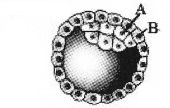
- Identify A and B.
- Mention the fate of A and B.
Answer:
- A-Inner cell mass B – Trophoblast
- Inner cell mass gives rise to embryo, Trophoblast – Foetal membranes, and placenta.
Question 5.
Give reason. ‘Corpus luteum functions as endocrine organ’.
Answer:
Corpus luteum secretes progesteron, a hormone, which helps for pregnancy.
Question 6.
Observe the flow chart showing the hormonal control of menstrual cycle.

- Observe and name the hormones A, B, C and D.
- Copy the flow chart and represent the feedback mechanism in that.
Answer:
1. A-FSH, B-L.H,
C – Estrogen D – Progesterone
2.
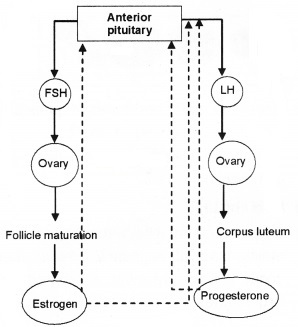
Question 7.
The relaxin secreted by placenta relaxes the public ligaments during parturition.
- What is placenta?
- Mention any two other hormones secreted by placenta.
Answer:
1. Placenta is the physiological connection between mother and developing young one.
2. Any two other hormones secreted by placenta:
- HCG (Human chorionic gonadotropin)
- HPL (Human Placental lactogen)
Question 8.
Redraw the following diagram and label the parts 1 to 5.

Answer:
- – Acrosome
- – Nucleus
- – Neck
- – Mitochondria
- – Tail
Question 9.
Study the picture showing events of menstrual cycle and answer the following questions.

- Name the major hormones responsible for the events shown in stage 1 and 2.
- Identify the structure shown in stage 3 and comment on its fate.
Answer:
- FSH and LH
- Corpus Luteum. It secretes progesteron for the maintenance of pregnancy. If fertilization fails to occur, it transforms into corpus albicang and degenerates.
Question 10.
Eggs are developed and matured in the ovary. Mature ovum released from ovary by ovulation.
- How many eggs are released by a human ovary in a month?
- How many eggs do you think would have been released if the mother gave birth to identical twins?
Answer:
- Normally one per month.
- Single ovum is released, which is fertilized by a single sperm. After fertilization, the zygote cleaves to form two identical twins.
Question 11.
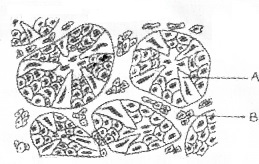
- Identify the figure and label portions A and B.
- How many chromosomes are present in human secondary spermatocyte?
Answer:
- A – Spermatogonia ; B – Interstitial cells
- 23 chromosomes
Question 12.
Name the structure with the following components.
- Embryo at 16 cell stage
- Mature ovum with follicle cells
- Myometrium and endometrium
- Trophoblasts, inner cell mass, blastcoel
Answer:
- Morula
- Graffian follicle
- Uterus
- Blastocyst
Question 13.
Diagram A & B show the important events in human reproduction.
- Give the name of these two processes, A & B seen in human reproduction.
- If there are differences in the processA& B, give details of it.
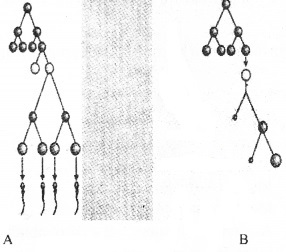
Answer:
- A – Spermatogenesis
B – Oogenesis - In spermatogenesis, meiotic division is equal leading to the formation of many functional sperms. Oogenesis division is unequal leading to the formation of a single ovum and other polar bodies degenerate.
Question 14.
Given the figure of section of ovary, label A and B. What is the significance of B if the egg fertilized.
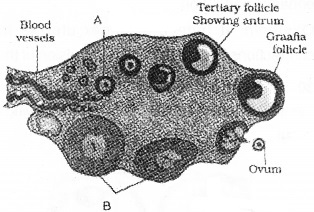
Answer:
A – Primary follicle B – Corpus leuteum
If egg is fertilized, corpus luteum secretes more progesterone, preparing endometrium for pregnancy.
Question 15.
Identify true/false statements. Correct if it is false.
- Sperms get nutrition from sertoli cells.
- Leydig cells are found in ovary.
- Presence or absence of hymen is not a reliable indicator of virginity or sexual experience.
- The first menstruation starts at puberty is called menopause.
Answer:
- True
- False. Leydig cells are found in testis.
- True
- False. The first menstruation is called menarch.
Question 16.
Observe the diagram.

Identify the labelled part A, B, C, and D.
Answer:
(A) Chrionic villi/placenta
(B) Yolk sac
(C) Umbilical cord
(D) Amniotic fluid
Question 17.
Name the foetal membrane that provides a fluid medium to the developing embryo. Mention its two functions.
Answer:
Amnion
- It prevents desiccation of the embryo.
- It provides a kind of private aquarium to the embryo and protects it from shocks.
Question 18.
Milk is secreted in the alveoli of mammary glands. Make a flow chart of the movement of milk from the alveoli to the buccal cavity of new born during breast feeding.
Answer:

Question 19.
- What is parturition?
- Which hormones are involved in induction of parturition?
Answer:
- The process of delivery of the foetus is called parturition.
- Oxytocin (Birth Hormone)
Question 20.
Germinal epithelium lining seminiferous tubules of testis contains Sertoli cells and germ cells. Give the functional difference between Sertoli cells and germ cells.
Answer:
1. Sertoli cells:
Nourishment of developing sperms.
2. Germ cells:
Produce spermatozoa by gametogenesis.
Question 21.
‘Hymen is not a reliable indicator for virginity’. Do you agree with the statement? Give reasons.
Answer:
Yes, Hymen is a soft, delicate membrane and can be ruptured easily by sudden fall, strenuous exercises, stretching (sports), cycling, etc.
Question 22.
During coitus, semen is deposited in the vagina. Give the path of sperm movement in female reproductive tract.
Answer:
Vagina → uterus → fallopian tube.
Fertilisation takes place in ampullary isthmic junction of fallopian tube.
Question 23.
Gametogenesis is classified as spermatogenesis and oogenesis. Differentiate between spermatogenesis and oogenesis.
Answer:
Production of sperm in Testes-Spermatogenesis Production of ovum in ovary – Oogenesis
Question 24.
Fertilization is the fusion of male and female gamete, which takes place in the fallopian tube.
- Discuss and point out the changes that occurs in the ovary after fertilization.
- Describe the changes that occurs in the uterus, if the ovum is not fertilized.
Answer:
- Ruptured follicle transforms into corpus luteum and Progesteron hormone is released.
- Endometrialial lining of the uterus degenerates and new uterine cycle begins.
Question 25.
Milk is produced in mammary glands towards the end of pregnancy.
- Name the first milk produced after parturition.
- Evaluate the advantages of getting first milk to a new born boaby.
Answer:
- Colostrum
- It is through the colostrum that the newborn gets maternal antibodies essential to develop immunity during early stages.
Question 26.
Write the roles of pituitary hormones in uterine and ovarian cycles in females.
Answer:
1. FSH:
promote oogenesis/influence estrogen synthesis.
2. LH:
Ovulation/Maintenance of Corpus luteum
Question 27.
Illustrate the sequential order of stages of human development from the following.
(morula, gametogenesis, cleavage, fertilization, blasulation, implantation, organogenesis, gastrulation)
Answer:
Gametogenesis → Fertilization → Cleavage → Morula → Blastulation → Implantations → Gastrulation → Organogenesis.
Question 28.
Parturition starts with foetal ejection reflex. Define foetal ejection reflex.
Answer:
Parturition signals originate from fully developed foetus which initiates uterine contractions leading to child birth.
Question 29.
A hormone injection is needed to overcome delay in delivery, Name-the hormonal injection given to enhance parturition.
Answer:
Oxytocin. It Induce stronger uterine muscle contractions leading to quicker expulsion of the baby.
Question 30.
Identify and label the parts where the following events occur.
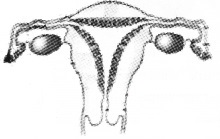
- Fertilization
- Implantation
Answer:
- Ampullary isthmus region of fallopian tube
- Endometrium
Question 31.
Placenta is a physiological connection between mother and foetus. Placenta is also an endocrine gland. Complete the given illustration with the hormones produced by the placenta.
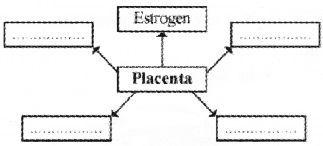
Answer:
Progesterone, HCG, HPL, Relaxin.
Question 32.
Arrange the following terms in two columns with suitable headings. (Seminiferous tubule, Uterus, vas deferens, Cervix, vagina, Epididymis)
Answer:
Male reproductive system
- Seminiferous tubule
- Vas deferens
- Epididymis
Female reproductive system
- Vagina
- Cervix
- Uterus
Plus Two Zoology Human Reproduction Three Mark Questions and Answers
Question 1.
Observe and study the graph.

- Find the relationship between FSH and Progesterone.
- What is the function of FSH?
- During pregnancy, how ovulation and menstruation prevented.
Answer:
- When FSH decreases progesterone increases.
- Formation and maturation of ovarian follicles.
- Because of high levels of progesterone. Progesterone inhibits the production of FSH, which helps for ovulation.
Question 2.
Based on the given diagram, prepare a flow chart explaining the process of spermatogenesis.
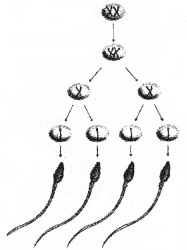
Answer:
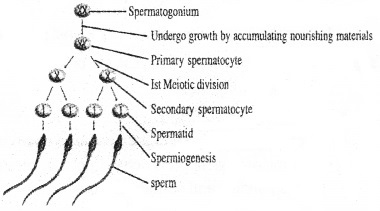
Question 3.
Diagrammatic presentation of various events during a menstrual cycle is given.
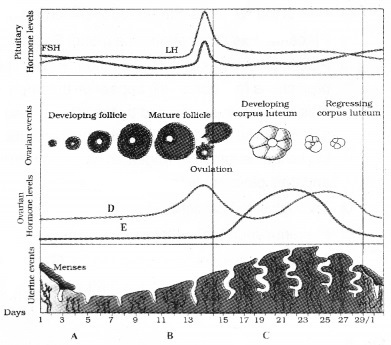
- Identify the uterine events A, B
- Name the ovarian hormones D&E.
- What happens to the level of E, if the ovum gets fertilized?
Answer:
- A – Menstrual phase
B – Proliferative/ follicular phase - D – Estrogen
E-Progesterone - The level of progesterone will increase after 20th day and it maintains even after 28th day.
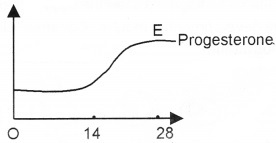
Question 4.
A pregnant lady was admitted to a hospital for delivery, but delivery is delayed than the expected time. Doctor prescribed to take a hormone injection.
- Name the hormone?
- Which gland in the body normally secrete this hormone?
- How this hormone helps in delivery?
Answer:
- Oxytocin
- Pituitary gland
- Oxytocin helps for the contraction of uterine muscles to facilitate delivery.
Question 5.
- When and how does placenta develop in human female?
- How is the placenta connefcted to the embryo?
- Placenta acts as an endocrine gland. Explain.
Answer:
1. Placenta develops after implantation. Finger-like projections (chorionic villi) appear on the tropho-blast which are surrounded by the uterine tissue and maternal blood. The chorionic villi and uterine tissue become interdigitated with each other and thus placenta is formed.
2. Through umbilical cord
3. Placenta secretes the following hormones:
- Human chorionic gonadotropin (hCG).
- Human placental lactogen (HPL)
- Progesterons and estrogens.
Question 6.
In female ovum is released normally on the 14th day of menstrual cycle.
- Name the process of release of ovum from the ovary.
- Where does the fertilization occur?
- What will happen to the grafian follicle if the ovum is fertilized?
Answer:
- Ovulation
- Fallopian tube
- It transforms into corpus luteum.
Question 7.
The following diagrams show the sequence of events in the development of mature of ovarian follicle and corpus luteum.

- Which are the main hormones produced by the ovary at the stages C & E?
- Which among the stages A to E would you expect is maintained by the ovary during pregnancy. Give reasons for your answer.
- Identify C.
Answer:
- The hormones produced are C – Estrogen E – Progesterone
- E is maintained (Corpus luteum)
Corpus luteum is necessary to produce progesterone which maintains pregnancy. - Mature graffian follicle.
Question 8.
FSH and LH are the hormones released by both female and males
- Which gland produce these hormones?
- Mention effects these hormones in the males and females?
- An ideal male contraceptive might be one that would suppress release of FSH but not of LH discuss. Why?
Answer:
1. Testis and Ovary.
2. FSH in female stimulates development of follicle, LH stimulates follicular development and development of corpus luteum. FSH in male stimulates sperm production, LH stimulates interstial cells to produce testosterone.
3. It suppress sperm production but not testosterone production, so male would be infertile but would still develop male secondary sexual characteristics.
Question 9.
Give reasons to the following.
- Newborn babies should strictly fed colostrum.
- Sex of the baby is determined by the father and not by the mother.
- Doctors inject oxytocin to induce delivery.
Answer:
1. Colostrum is the first milk, which contain several antibodies absolutely essential for developing resistance for new born babies.
2. Females produce gametes with X only. Males, on the other hand, produce sperms which carry 50 percent X and 50 percent Y chromosome. Thus zygote with XX becomes female and XY chromosome becomes male.
3. Oxytocin acts on uterine muscles and causes stronger contractions, which leads to the expulsion of baby through birth canal.
Question 10.
What are the major components of seminal plasma?
Answer:
- The secretions of seminal vesicles, prostate gland, and cowper’s glands.
- Spermatozoa
- About 70% of the seminal plasma is secreted by seminal vesicles. It is rich in fructose, citrate, prostaglandins and certain enzymes.
Question 11.
During Oogenesis, in human female, a primary oocyte produces four haploid cells. Out of these four haploid cells, only one is used in reproduction. Then
- What is the fate of the haploid cells used in reproduction?
- What happens to the other three haploid cells?
- What is the significance of this type of meiotic division during oogenesis?
Answer:
- Haploid cells develop into ovum/ female gamete
- Other three haploid cells transform to polar bodies and degenerate.
- It helps for reducing chromosome number and also restricts the number of ovum.
Question 12.
The graph shows the level of ovarian hormones in a normally menstruating woman during follicular phase.

- Name ‘a’ and ‘b’.
- Mention the role of pituitary hormones in maintaining this condition.
- Reconstruct the hormonal graph for luteal phase.
Answer:
- a. Estrogen
b. Progesteron - FSH :
Influence spermatogensis and oogenesis/ influence estrogen hormone
LH :
Ouvlation / Maintenance of Corpus luteum
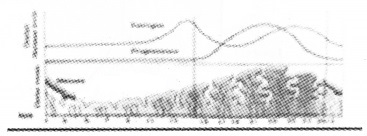
Question 13.
Placenta facilitates the supply of O2 and nutrients to the embryo and removal of CO2 and excretory waste products produced by the embryo. Apart from this, placenta is considered as an endocrine tissue. Justify.
Answer:
Placenta produces a number of hormones, which are inevitable for pregnancy and parturition. They are:
- Human chorionic gonadotropins (HCG)
- Human placental lactogen (HPL)
- Estrogen
- Progesterone
- Relaxin etc.
Question 14.
Analyse the process of gametogenesis given below. Answer the following questions.

- Identify and name the type of gametogenesis illustrated.
- Identify cell ‘b’ & cell ‘c’ and explain their fate.
- Compare the chromosome numbers of cell ‘a’ & cell ‘c’.
Answer:
1. Oogenesis
2. Identify cell ‘b’ & cell ‘c’ and explain their fate:
- Polar body degenerates
- Secondary oocyte develops into ovum
3. Cell ‘a’ has 46 chromosomes, and cell ‘c’ has 23 chromosomes
Question 15.
Look at the table, which summerises hormonal interaction that can occur in a female human. From the list of hormones given, select the one hormone which is most important in each of the eight pathways, 1 to 8, shown.

- Progesterone
- Oestrogen
- LH
- LH releasing factor
- Oxytocin
- Prolactin
- FSH releasing factor
- FSH
Answer:
Pathway
- LH Releasing Factor
- FSH releasing factor
- LH
- FSH
- Prolactin
- Estrogen
- Estrogen Progesterone
- Oxytocin
Question 16.
Name the hormone responsible for the descent of tests of into the scrotum. Why does the failure of the process result in sterility?
Answer:
Follicle stimulating hormone (FSH) Non descent of testes in scrotum causes sterility because spermatogenesis requires low temperature and inside the scrotum, the temperature is 2-2.5°C lower than the normal. This defect is usually cured by simple surgical process.
Question 17.
Match the column A with column B and Column C.
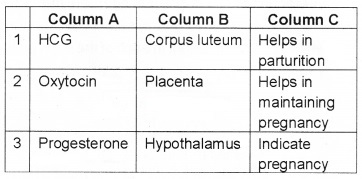
Answer:
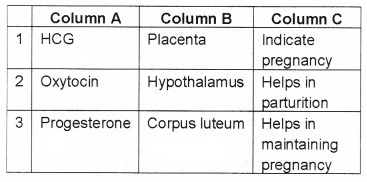
Plus Two Zoology Human Reproduction NCERT Questions and Answers
Question 1.
What are the major components df seminal plasma?
Answer:
- The secretions of seminal vesicles, prostate gland, and Cowper’s glands.
- Spermatozoa
- About 70% of the seminal plasma is secreted by seminal vesicles. It is rich in fructose, citrate, prostaglandins and certain enzymes.
Question 2.
What are the major functions of male accessory ducts and glands?
Answer:
Male accessory ducts store and transport the sperms from testis to the outside through urethra. Male accessory glands secrete seminal Plasma, Which is rich in fructose, citrate, prostaglandins and certain enzymes. The secretion of Cowper’s glands lubricate the penis.
Question 3.
Write functions of the following:
- Corpus luteum
- Endometrium
- Acrosome
- Sperm tail
- Fimbriae
Answer:
1. Corpus Luteum. It secretes progesterone hor-mone which prepares the endometrium of uterus for implanation, placenation and normal development of foetus. So it maintains the pregnancy.
2. Endometrium. It is innermost, highly vascular and glandular lining of uterus. It undergoes cyclic changes during menstrual cycle and prepares itself for implanation of blastocyst and placentation.
3. Acrosome of head of sperm secretes sperm lysins like hyaluroindase (which dissolves hyaluronic acid of eff locally); corona pernetrating enzyme (which dissolves corona radiated) and acrosin (which dissolves zona pellucia).
4. Sperm tail. It shows lashing movements which provide forward push to the sperm.
5. Fimbriae are finger-like processes of fallopian tube which increase the chances of trapping of ovum released from the ovary.
Question 4.
What is oogenesis? Give a brief account of oogenesis.
Answer:
The process of formation of female gametes is called oogenesis.
Process:
During embryonic stage millions of gametes mother cells are formed (oogonia). This is covered by primary follicles. At the attainment of puberty, about 60,000 + 80,000 primary follicles are left in each overy.
Now it gets surrounded by secondary follicles. Then formation of tertiary follicle takes place. Tertiary follicle matures into Graaffian follicle – Tertiary Follicle ruptures to release secondary ooclyle by the process called ovulation.
Question 5.
- What is menstrual cycle?
- Which hormones regulate menstrual cycle?
Answer:
1. Menstrual Cycle. During the reproductive period of female primates, the ovaries produce ova at regular intervals of about 28/29 days and changes take place in the uterus in preparation for a possible pregnancy. This series of cyclic changes known as menstrual cycle. The most peculiarfeature of this cycle is the monthly vaginal bleeding called menses.
2. Hormonal control:
- Anterior Pituitary
- FSH
- LH
- Ovary
- Estrogen
- Progesterone
Question 6.
In our society, women are often blamed for giving birth to daughters. Can you explain why this is not correct?
Answer:
Male produces two types of gametes (Sperms), 50% of sperms carry X chromosome, while the other 50% carry Y chromosome, while female produces only one type of gametes (ova), each carrying X chromosome. after fusion of the male and female gametes, the zygote would carry either XX or XY depending on whether the sperm carrying X or Y fertilized the ovum.
The zygote carrying XX would develop into a female baby and XY would form a male baby. Thus, the sex of the baby is determined by the father and not by the mother.
Question 7.
- How many eggs are released by a human ovary in a month?
- How many eggs do you think would have been released if the mother gave birth to identical twins?
- Would your answer change if the twins? Would your answer change if the twins born were fraternal?
Answer:
- Only one egg is released by human ovaries in a month.
- Single egg was released in case of identical twins.
- In case of fraternal twins, two eggs are released and get fertilized.
Plus Two Zoology Human Reproduction Multiple Choice Questions and Answers
Question 1.
The part of fallopian tube closest to the ovary is
(a) isthmus
(b) infundibulum
(c) cervix
(d) ampulla
Answer:
(b) infundibulum
Question 2.
Which one of the following statements about human sperm is correct?
(a) Acrosome has a conical pointed structure used for piercing and penetrating the egg, resulting in fertilization
(b) The sperm lysins in the acrosome dissolve the egg envelope facilitating fertilization
(c) Acrosome serves as a sensory structure leading the sperm towards the ovum
(d) Acrosome serves no particular function
Answer:
(b) The sperm lysins in the acrosome dissolve the egg envelope facilitating fertilization
Question 3.
Seminal plasma in human males in rich in
(a) fructose and calcium
(b) glucose and calcium
(c) DNA and testosterone
(d) ribose and potassium
Answer:
(a) fructose and calcium
Question 4.
Sertoli’s cells are found in
(a) ovaries and secrete progesterone
(b) adrenal cortex and secrete adrenalin
(c) semiliferous tubules and provide nutrition to germ cells
(d) pancreas and secrete cholecystokinin
Answer:
(c) semiliferous tubules and provide nutrition to germ cells
Question 5.
Across section at the midpoint of the middle piece of a human sperm will show
(a) centriole, mitochondria and 9+2 arrangement of microtubules
(b) centriole and mitochondria
(c) mitochondria and 9+2 arrangement of microtubules
(d) 9+2 arrangement of microtubules only
Answer:
(c) mitochondria and 9+2 arrangement of microtubules
Question 6.
Graafian follicle contains
(a) oogonial cells
(b) corpus luteum
(c) theca externa and theca intemna
(d) corpus albicans
Answer:
(c) theca externa and theca intemna
Question 7.
Synthesis of testosterone by Leydig cells is stimulated by
(a) LTH
(b) TSH
(c) FSH
(d) ICSH
Answer:
(d) ICSH
Question 8.
Which gland in female is a counterpart of Cowper’s gland in male?
(a) Bartholin’s gland
(b) Clitoris
(c) Perineal gland
(d) None of these
Answer:
(d) None of these
Question 9.
Corpus luteum is developed from
(a) Oocyte
(b) nephrostome
(c) Graafian follicle
(d) None of these
Answer:
(c) Graafian follicle
Question 10.
Progesterone hormone is secreted by
(a) corpus albicans
(b) corpus callosum
(c) corpus luteum in ovaries
(d) corpus uteri
Answer:
(c) corpus luteum in ovaries
Question 11.
The second maturation division of the mammalian ovum occurs
(a) shortly after ovulation before the ovum makes entry into the fallopian tube
(b) until after the ovum has been penetrated by a sperm
(c) until the nucleus of the sperm has fused with that of the ovum
(d) in the Graafian follicle following the first maturation division
Answer:
(b) until after the ovum has been penetrated by a sperm
Question 12.
Which one of the following statements about morula in humans is correct
(a) It has almost equal quantity of cytoplasm as an uncleaved zygote but much more DNA
(b) It has far less cytoplasm as well as less DNA than in an uncleaved zygote
(c) It has more or less equal quantity of cytoplasm and DNA as in uncleaved zygote
(d) It has more cytoplasm and more DNA than an uncleaved zygote
Answer:
(d) It has more cytoplasm and more DNA than an uncleaved zygote
Question 13.
The signals for parturition originates from
(a) placenta only
(b) placenta as well as fully developed foetus
(c) oxytocin released from maternal pituitary
(d) fully developed foetus only
Answer:
(b) placenta as well as fully developed foetus
Question 14.
The first movements of the foetus and appearance of hair on its head are usually observed during which month of pregnancy?
(a) Fourth month
(b) Fifth month
(c) Sixth month
(d) Third month
Answer:
(b) Fifth month
Question 15.
Which one of the following is the correct matching the events occurring during menstrual cycle?
(a) Ovulation — LH, and FSH attain peak level and sharp fall in the secretion of progesterone
(b) Proliferative — Rapid regeneration of myometrium and maturation of Graafian follicle
(c) Development — Secretory phase and increased secretion of corpus luteum of progesterone
(d) Menstruation — Breakdown of myometrium and ovum not fertilized
Answer:
(c) Development — Secretory phase and increased secretion of corpus luteum of progesterone
Question 16.
Sertoli cells active for providing the
(a) motility of sperm
(b) nutrition of germ cells
(c) secretion of testosterone
(d) none of the above
Answer:
(b) nutrition of germ cells
Question 17.
Testicular hormones called androgens are synthesized by
(a) sertoli cells
(b) germ cells
(c) Leydig cells
(d) bulbourethral glands
Answer:
(c) Leydig cells
Question 18.
The correct sequence of male sex accessory ducts is
(a) rete testis, vasa efferentia, and vas deferens
(b) epididymis, rete testis, vasa efferentia, and vas deferens
(c) rete testis, epididymis ,vasa efferentia, and vas deferens
(d) epididymis, vasa efferentia,epididymis and rete testis
Answer:
(a) rete testis, vasa efferentia, and vas deferens
Question 19.
The secretion of male accessory glands contains
(a) glucose and calcium
(b) fructose, calcium
(c) fructose and magnesium
(d) fructose, calcium, and zinc
Answer:
(b) fructose, calcium
Question 20.
Which gland responsible for the lubrication of penis at the time coitus
(a) seminal vesicles, prostate, and bulbour thral glands
(b) prostate and bulbourethral glands
(c) bulbourethral glands
(d) none of the above
Answer:
(c) bulbourethral glands
Question 21.
The finger-like projections in female reproductive structure collects ovum
(a) infundibulum
(b) fimbriae
(c) ampulla
(d) fallopian tube
Answer:
(b) fimbriae
Question 22.
The correct sequence of fallopian tube is
(a) isthmus, ampulla, infundibulum, and fimbriae
(b) ampulla isthmus, infundibulum, and fimbriae
(c) infundibulum, fimbriae, isthmus, and ampulla
(d) none of the above
Answer:
(a) isthmus, ampulla, infundibulum, and fimbriae
Question 23.
Which layer of uterus undergoes cyclical changes during menstrual cycle
(a) perimetrium
(b) myometrium
(c) endometrium
(d) all the above
Answer:
(c) endometrium
Question 24.
The tiny finger-like structure clitoris is located at
(a) near uterus
(b) near labia majora
(c) near labia minora
(d) near fallopian tube
Answer:
(c) near labia minora
Question 25.
Which one of the following undergoes mitosis
(a) sprmatogonia
(b) primary spermatocyte
(c) secondary spermatocyte
(d) spermatids
Answer:
(a) sprmatogonia
Plus Two Zoology Human Reproduction SCERT Sample Questions and Answers
Question 1.
Transferring of Zygote/embryo with more than 8 blastomeres into fallopian tube is………… (1)
Answer:
ZIFT
Question 2.
- How many sperms and ova are produced from 50 primary spermatocyte and 50 primary oocyte respectively?
(100 sperms and 100 eggs, 200 sperms and 100 ova, 200 sperms and 50 ova, 50 sperms and 50 ova) (1) - Observe the diagram carefully and identify a, b, c and d. (2)
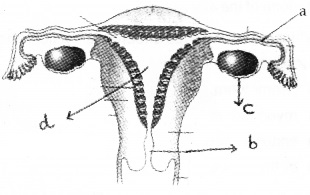
Answer:
1. – 200 sperms & 50 ova
2. identify a, b, c, and d:
- b – a. Fallopian tube
- b. Vagina
- c. Ovary
- d. Uterus
We hope the given Plus Two Zoology Chapter Wise Questions and Answers Chapter 1 Human Reproduction will help you. If you have any query regarding Plus Two Zoology Chapter Wise Questions and Answers Chapter 1 Human Reproduction, drop a comment below and we will get back to you at the earliest.
